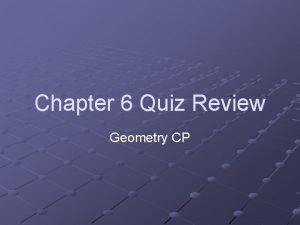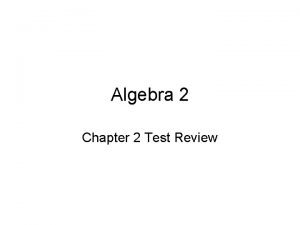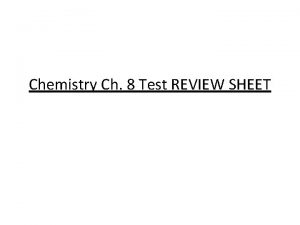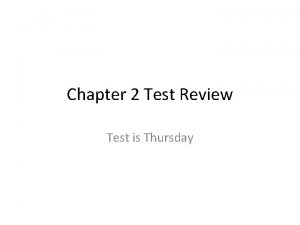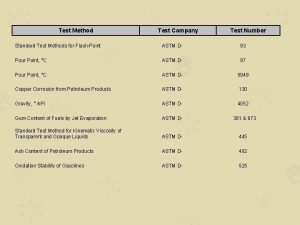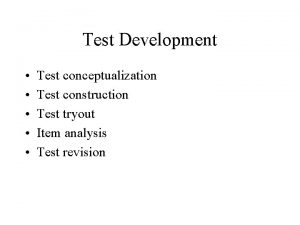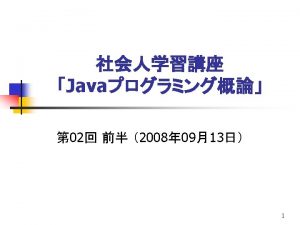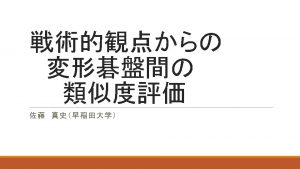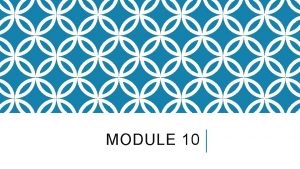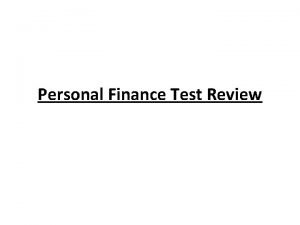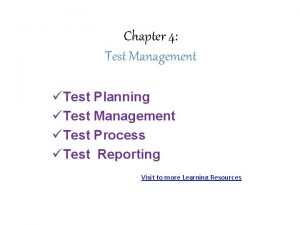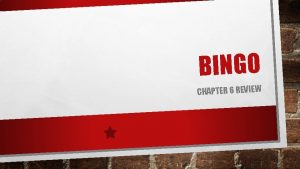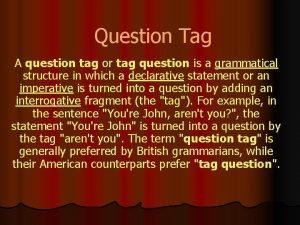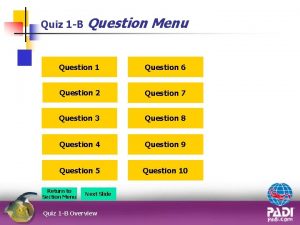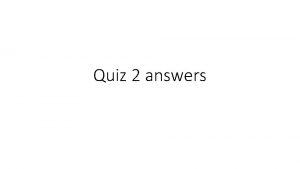Chapter 17 Test Review Question 1 In a
























- Slides: 24

Chapter 17 Test Review

Question 1 • In a transverse wave, ___ is measured from crest to crest or from trough to trough. • a. wave speed • b. amplitude • c. wavelength • d. frequency c.

Question 2 • • Which letter represents the wavelength? a. A b. B c. c. C

Question 3 • What is the amplitude of the wave? • a. 24 m b. 2. 5 m c. 1. 5 m b. d. 5 m

Question 4 • True or False? • To compare the energy of different waves, measure the wavelength of the waves. False, Energy is related to frequency.

Question 5 Transverse and longitudinal waves both a. have compressions and rarefactions. b. transfer energy through a medium. c. are capable of moving the medium a long distance. • d. move at right angles to the vibration of the medium. • • b.

Question 6 • Which letter represents the amplitude? • a. A b. B c. C d. D e. E

Question 7 • In longitudinal waves the motion of the vibration is ____ to the direction in which the wave travels. • a. transverse • b. parallel b. • c. perpendicular • d. in a circular motion

Question 8 • You are shaking the end of a rope to make a wave. You start shaking the rope the same distance, but more rapidly. What happens to the frequency and wavelength? • a. both frequency and wavelength decrease • b. both frequency and wavelength increase • c. frequency increases; wavelength decreases • d. frequency decreases; wavelength increases c.

Question 9 • What is the difference between wave A and wave B? • a. Wave B has an amplitude that is one half the amplitude of wave A. • b. Wave B has a wavelength that is 4 times that of wave A • c. Wave A has a wavelength that is 3 times that of wave B • d. Wave A has an amplitude that is one half the amplitude of wave B A.

Question 10 • What is the difference between wave C and wave D? • a. Wave C has a frequency half that of wave D; Therefore, the wavelength in wave D is one half that of wave C. • b. Wave D has a frequency twice that of wave C; Therefore, the wavelength in wave D is twice that of wave C. • c. Wave C has a frequency twice that of wave D; Therefore, the wavelength in wave C is one half that of wave D. • d. Wave D has a frequency half that of wave C; Therefore, the wavelength of wave C is half that of wave D A.

Question 11 • In longitudinal waves the motion of the vibration is ____ to the direction in which the wave travels. • a. parallel • b. perpendicular • c. transversed. • In a circular motion A.

Question 12 • Which letter represents the resting position? • a. A b. B c. C d. D e. E A.

Question 13 • In which medium does sound travel the fastest? • a. cast iron A. • b. salt water • c. fresh water • d. air

Question 14 • • • ___ is the unit that measures wave frequency? a. m/s b. hertz B. c. newtons d. decibel

Question 15 • An ambulance siren sounds different as it approaches you than when it moves away from you. What scientific term would you use to explain how this happens? • a. rarefaction • b. the Doppler effect • c. diffraction B. • d. ultrasound

Question 16 • True or False • Reflection is the bending of a wave as it enters a new medium at an angle. False, It should be refraction.

Question 17 • A ___ is the material through which a mechanical wave travels. • a. transverse wave • b. medium • c. longitudinal wave • d. wavelength B.

Question 18 • Suppose two waves collide and the temporary combined wave that results is smaller than the original waves. What term best describes this interaction? • a. constructive interference • b. destructive interference • c. standing wave formation • d. diffraction B.

Question 19 • To what is amplitude related? • a. the amount of energy carried by the wave • b. the maximum displacement from the rest position • c. neither A nor B • d. both A and B D.

Question 20 • Which type of mechanical wave needs a source of energy to produce it? • a. a transverse wave • b. a surface wave • c. a longitudinal wave • d. all of the above D.

Question 21 • In which medium would sound travel the slowest? • a. air • b. cast iron • c. salt water • d. fresh water A.

Question 22 • Consider the properties of a wave—wave speed, amplitude, wavelength, period, and frequency. Which two properties are required to calculate the velocity of a wave? • a. wavelength & frequency • b. period & frequency A. • c. wave speed & period • d. wave speed & frequency • e. amplitude & wavelength

Question 23 • • • To find amplitude, measure a. from a trough to the rest position. b. from a crest to the rest position. c. neither A nor B d. either A or B D.
 Costas higher level questions
Costas higher level questions Chapter review motion part a vocabulary review answer key
Chapter review motion part a vocabulary review answer key Algebra 2 unit 1 test answers
Algebra 2 unit 1 test answers Geometry chapter 6 quiz
Geometry chapter 6 quiz Algebra 2 chapter 2 practice test
Algebra 2 chapter 2 practice test Chapter 8 test review chemistry
Chapter 8 test review chemistry Present simple question words
Present simple question words Clearinghouse probe
Clearinghouse probe Contoh open-ended question adalah
Contoh open-ended question adalah Non researchable question
Non researchable question Direct into indirect questions
Direct into indirect questions Compelling and supporting questions examples
Compelling and supporting questions examples Compelling questions
Compelling questions Chapter 6 career readiness chapter review answers
Chapter 6 career readiness chapter review answers Ap gov final review
Ap gov final review Narrative review vs systematic review
Narrative review vs systematic review Systematic review definition
Systematic review definition Narrative review vs systematic review
Narrative review vs systematic review Eet test
Eet test Theoretical foundation of nursing exam
Theoretical foundation of nursing exam Chapter 7 similarity
Chapter 7 similarity Chapter 4 population ecology test answer key
Chapter 4 population ecology test answer key The tragedy of julius caesar unit test review
The tragedy of julius caesar unit test review The crucible character traits
The crucible character traits Logarithms test review
Logarithms test review



